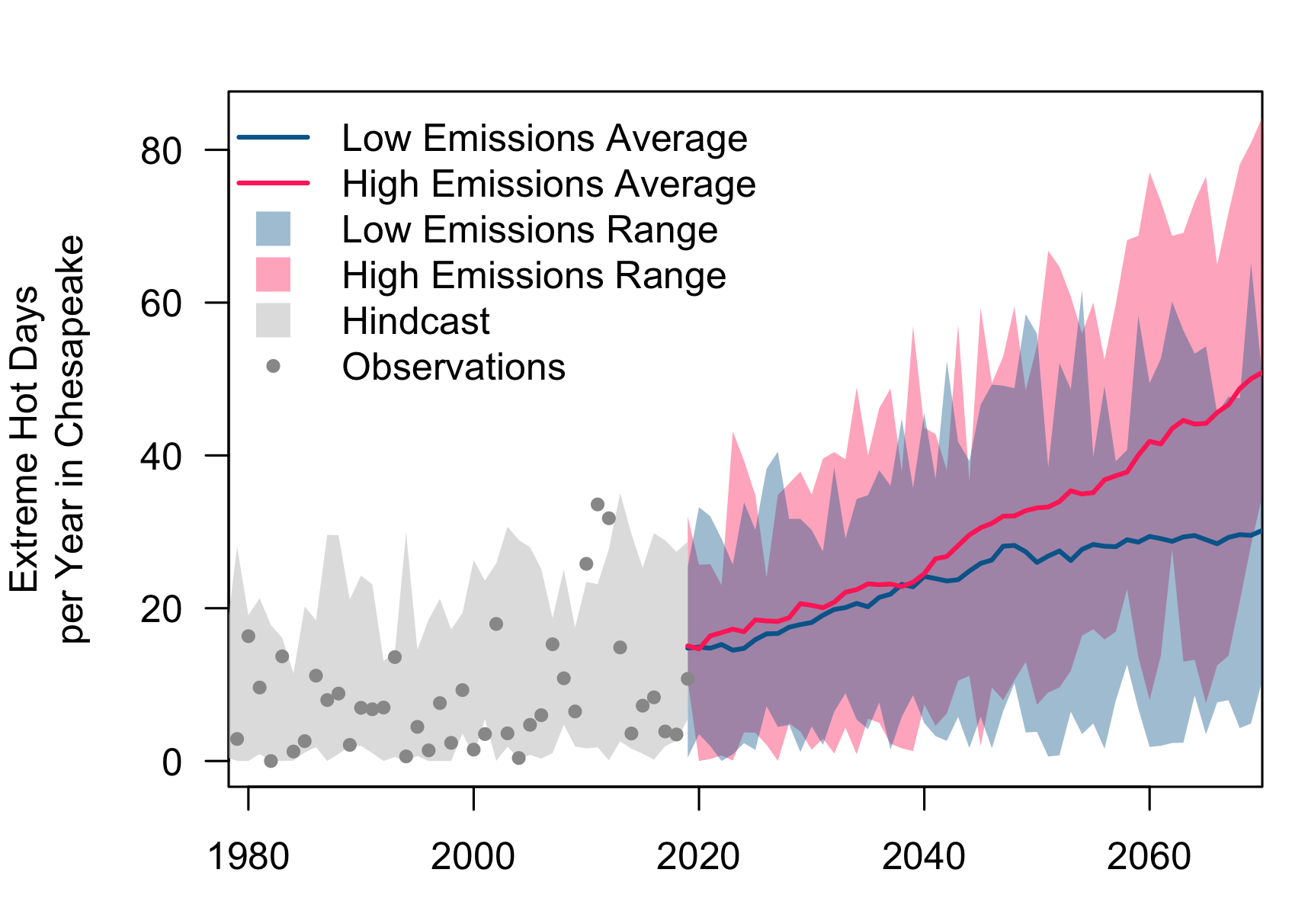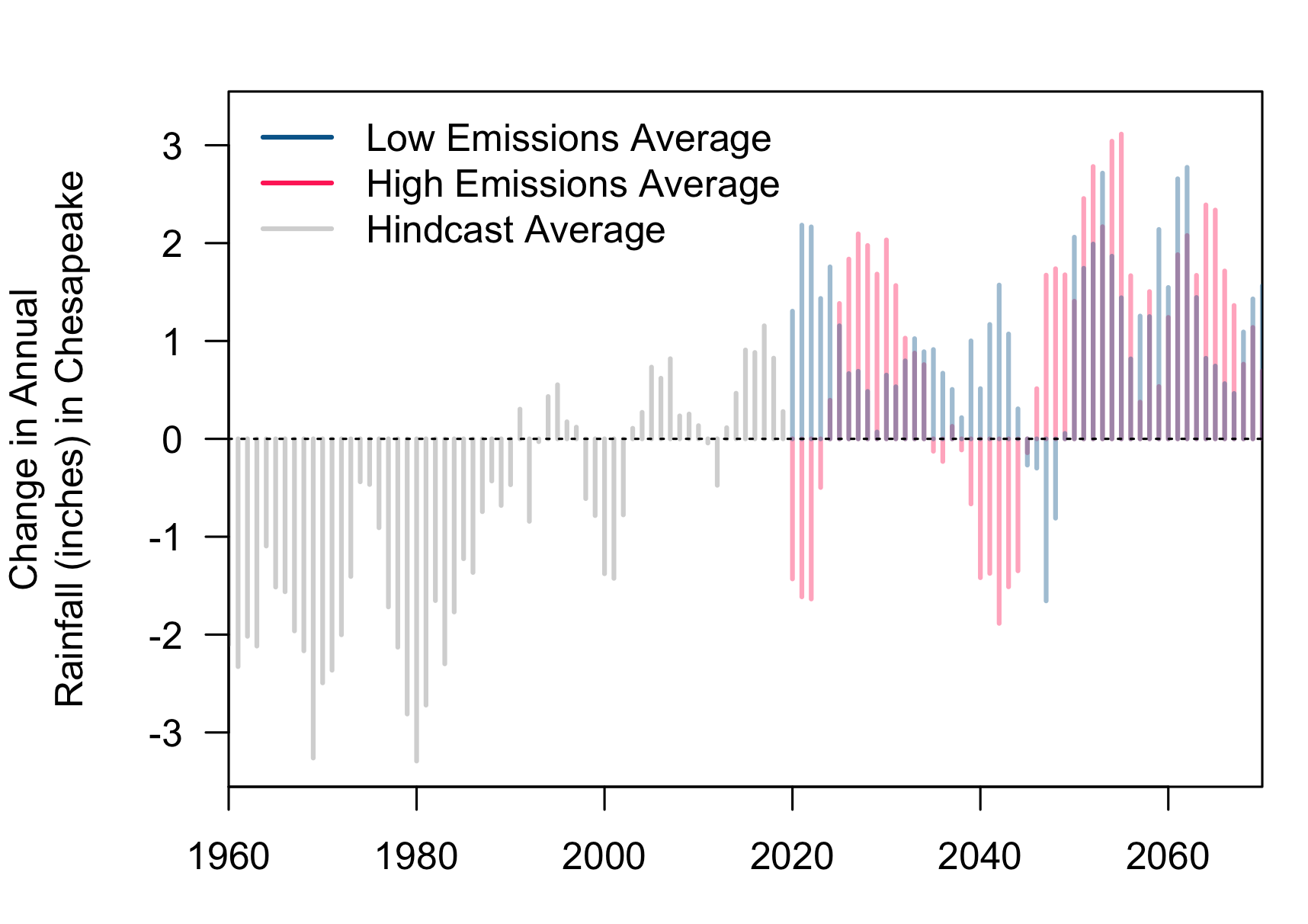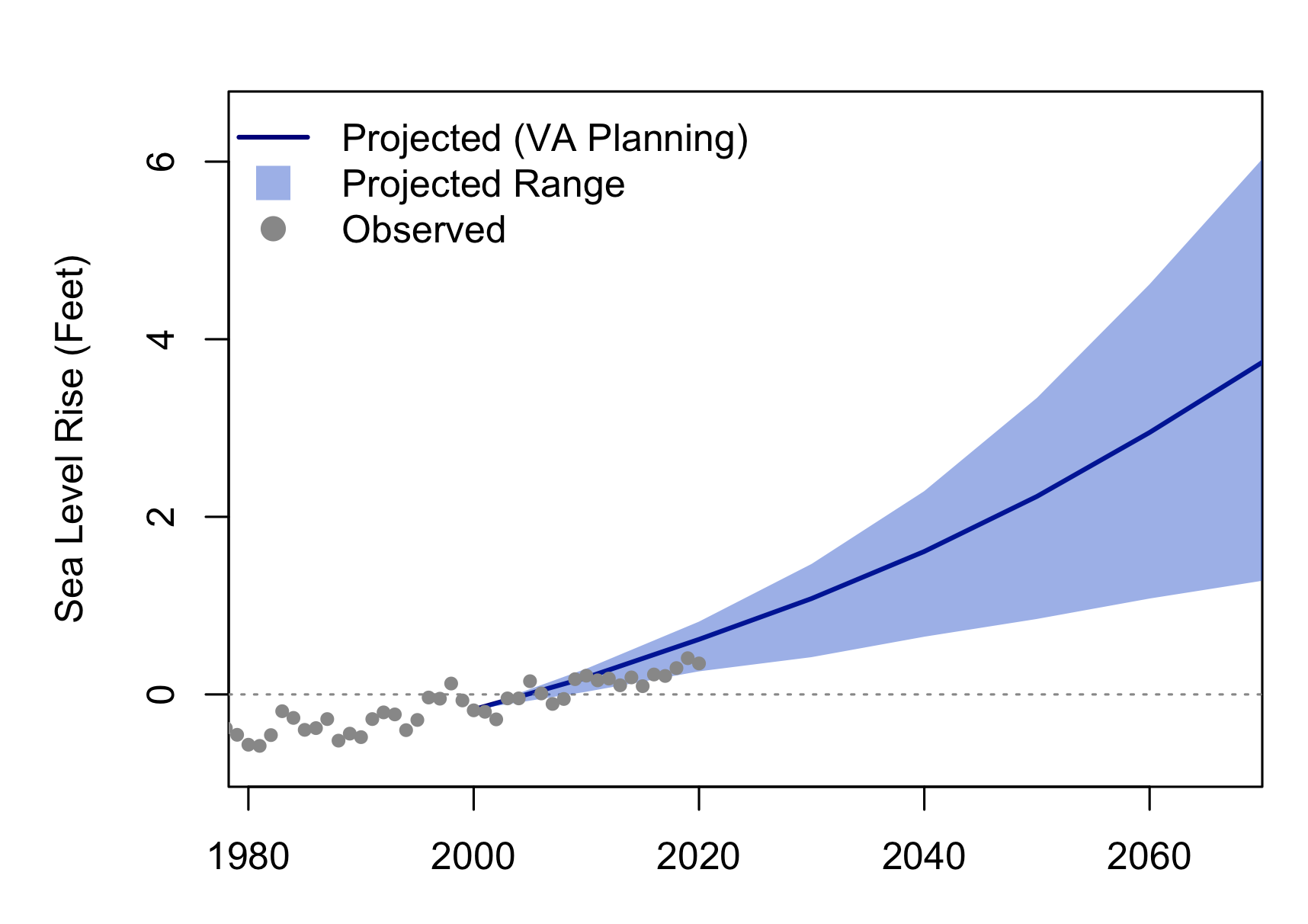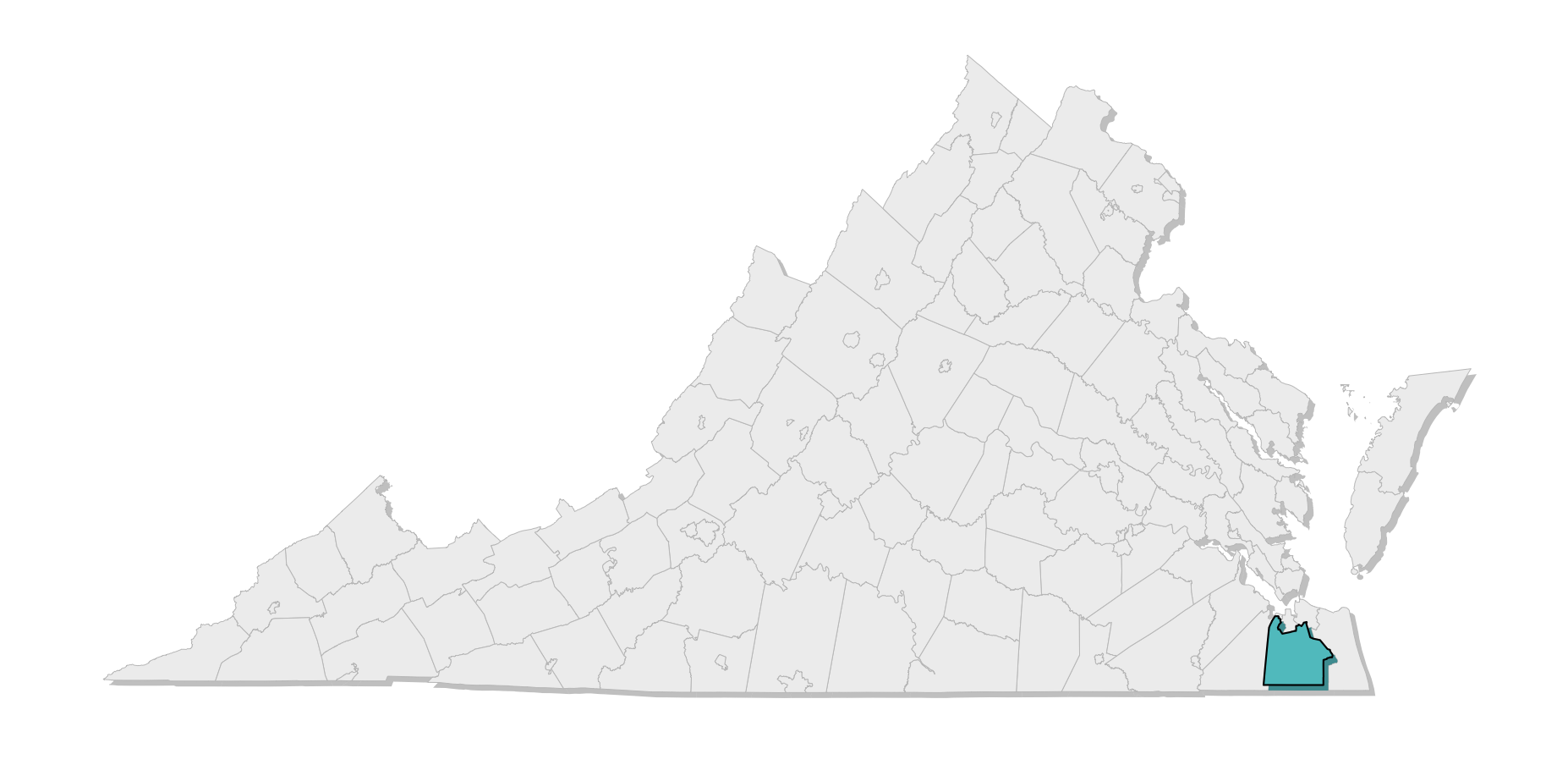Chesapeake, VA
Chesapeake residents will face increasingly severe weather-related hazards, such as heat waves, flooding, and storm surge.
As the frequency and intensity of local hazards change, it is important for all of us to protect communities and local habitats. Using the best data, scientists can project how long-term averages in daily weather will change in the future, and the effects this will have on localities.
Information on extreme weather and hazards can empower citizens, decision-makers, and other stakeholders to make infored risk-reduction decisions. With planning and preparation, Chesapeake can reduce risks for all residents.

Changing Temperature Patterns
Human health, local fisheries, and infrastructure are all threatened by higher temperatures. At 95°F, it is hard to keep indoor areas and our bodies cool. Chesapeake’s summers are getting hotter. On average, Chesapeake sees 9 days per year with temperatures above 95°F (1990-2019 average). Within the next 50 years (by 2070), Chesapeake can expect a yearly average of 30 to 51 days above 95°F, with associated increases in cooling costs, reduced air quality, and heat-related illnesses.
![]() HEAT-RELATED ILLNESSES: Heatwaves can kill people and pets. More than 100 Virginians have died from extreme heat between 2010 and 2019. Individuals at higher risk include children, pregnant women, older adults, outdoor workers, and lower-income residents.
HEAT-RELATED ILLNESSES: Heatwaves can kill people and pets. More than 100 Virginians have died from extreme heat between 2010 and 2019. Individuals at higher risk include children, pregnant women, older adults, outdoor workers, and lower-income residents.
![]() DISRUPTED FISHERIES: Across the Mid-Atlantic, stream temperatures increased roughly 2.5 degrees F from 1960 to 2010. Warmer water stores less dissolved oxygen, which threatens the survival of rockfish, oysters, and soft-shelled crabs, and disrupts local fisheries and ecosystems.
DISRUPTED FISHERIES: Across the Mid-Atlantic, stream temperatures increased roughly 2.5 degrees F from 1960 to 2010. Warmer water stores less dissolved oxygen, which threatens the survival of rockfish, oysters, and soft-shelled crabs, and disrupts local fisheries and ecosystems.

The graph shows the number of days in a year with temperatures above or equal to 95°F. Dots represent observed annual days of extreme temperatures and the gray shading shows the hindcast1. Two scenarios of the future are shown as a high-emissions scenario (RCP 8.5) in red and a low-emissions scenario (RCP 4.5) in blue. Data for the future scenarios are retrieved from Multivariate Adaptive Constructed Analogs (MACA), and observed data are from the Gridded Surface Meteorological Dataset (gridMET).
Changing Rainfall Patterns
Heavy rainfall in Chesapeake is increasing in frequency and intensity, causing property damage, septic backups, and impacts to water quality in wells, local streams, mold and indoor air quality issues, and the Chesapeake Bay. Annual rainfall in Chesapeake will likely increase by an average of 2 inches (2050-2079 average compared to the 1990-2019 average).
![]() FLOODING: Heavy rain overwhelms infrastructure and drainage systems, causing property damage and covering roads.
FLOODING: Heavy rain overwhelms infrastructure and drainage systems, causing property damage and covering roads.
![]() REDUCED HUMAN HEALTH: Rising water tables cause septic backups and groundwater pollution, putting drinking water at risk of contamination. Changing moisture levels impact the spread of mold and illness, including tick- and mosquito-borne diseases as high humidity promote their activity.
REDUCED HUMAN HEALTH: Rising water tables cause septic backups and groundwater pollution, putting drinking water at risk of contamination. Changing moisture levels impact the spread of mold and illness, including tick- and mosquito-borne diseases as high humidity promote their activity.

The graph shows the change in annual rainfall compared to the average between 1990 and 2019. The gray lines show the hindcast. Two scenarios of the future are shown as a high-emissions scenario (RCP 8.5) in red and a low-emissions scenario (RCP 4.5) in blue. Data for the future scenarios are retrieved from MACA.
Sea Level Rise
As temperatures warm, land ice melts and seawater expands causing sea levels to rise around the world. Between 1950 and 2019, sea levels in Virginia rose roughly 1 foot leading to more frequent and severe coastal flooding, and property damage. Sea levels will rise an additional 1 to 6 feet in the next 50 years (by 2070), submerging property and permanently reshaping Chesapeake’s coastline.
![]() FLOODING: Rising sea levels allow tides, waves, and severe flooding to push further inland. This causes more frequent high tide flooding and increases the impacts of storm surge, putting low-lying housing, commercial property, and infrastructure at risk.
FLOODING: Rising sea levels allow tides, waves, and severe flooding to push further inland. This causes more frequent high tide flooding and increases the impacts of storm surge, putting low-lying housing, commercial property, and infrastructure at risk.
![]() SALTWATER INTRUSION: As saltwater from sea level rise pushes further upstream and seeps into ground water, it threatens drinking water and agriculture. Saltwater intrusion can force farmers to abandon fields and municipalities to increase investments in desalination treatments.
SALTWATER INTRUSION: As saltwater from sea level rise pushes further upstream and seeps into ground water, it threatens drinking water and agriculture. Saltwater intrusion can force farmers to abandon fields and municipalities to increase investments in desalination treatments.

The graph shows the projected change of sea level in feet above NAVD88 compared to the 1983-2001 average. The blue line shows the sea level rise scenario used for official planning purposes in Virginia. The blue shading shows the range between the low and extreme scenarios for sea level rise. Dots show the observed changes in sea level at Sewell’s Point, VA. Data for the future scenarios are retrieved from the National Oceanic and Atmospheric Administration (NOAA).
Development of the Local Hazard Outlooks was supported by the National Oceanic and Atmospheric Administration (NOAA) grants NA18OAR4310302 and NA21OAR4310310.
v2.0-beta1 2025-06-04
Footnotes
Hindcasts are model results for a historical period. Hindcasts are useful for comparing observations with model estimates.↩︎
